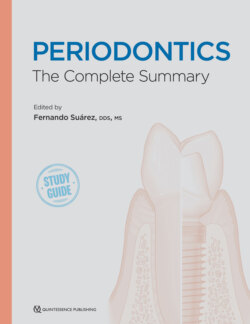Читать книгу Periodontics - Fernando Suarez - Страница 89
На сайте Литреса книга снята с продажи.
Developmental Deformities ENAMEL PROJECTIONS
ОглавлениеDefined as an apical extension of enamel usually toward a furcation,1 enamel projections (also known as cervical enamel projections [CEPs]) are common anatomical variations where a definitive projection of enamel extends into the furcation area, preventing true attachment of periodontal ligament (PDL) fibers upon the root surface7 (Fig 5-1).
Fig 5-1 Classification of cervical enamel projections.
Early observations in dental anatomy described how the enamel dips into the furcation area of multirooted teeth in a tongue-like fashion.42–48 A landmark article by Masters and Hoskins examined extracted teeth with CEPs and suggested a grading system to determine the severity of these projections (Box 5-2).7 The authors reported the prevalence of CEPs in mandibular and maxillary molars as 28.6% and 17%, respectively. In addition, clinical observations revealed that 90% of isolated furcation involvements were associated with CEPs and mainly affected buccal furcation entrances.7
BOX 5-2 Grading system for cervical enamel projections by Masters and Hoskins7
| Grade IGrade IIGrade III | A distinct change in CEJ attitude with enamel projecting toward the bifurcation.Enamel projection approaching the furcation but not actually making contact with it.Enamel projection extending into the furcation proper. |
A myriad of studies continued exploring the prevalence, incidence, and association between CEPs and furcation involvement (Table 5-2).7,49–55 Variations within these investigations might arise from differences in tooth type, reason for tooth extraction (eg, caries, severe periodontitis, endodontic failure), and patient population. With the exception of Leib et al,50 most studies confirmed a positive correlation between CEPs and furcation defects. Notably, Hou and Tsai reported a high prevalence (63.2%) of furcation defects associated with CEPs and intermediate bifurcational ridges (IBRs) affecting primarily mandibular molars.55
TABLE 5-2 Prevalence of enamel projections
| Authors | Material and methods | Main findings |
| Masters and Hoskins7 | Extracted teethPopulation not specified | Prevalence:– Mandibular molars: 28.6%– Maxillary molars: 17%90% of isolated furcation involvements were associated with CEP |
| Grewe et al49 | Extracted teethPopulation not specified | Prevalence:– Mandibular: 25.2%– Maxillary: 15.8%Frequency (in order):– Mandibular second molars– Maxillary second molars– Mandibular first molars– Mandibular third molars– Maxillary third molars– Maxillary first molars |
| Leib et al50 | Extracted teethPopulation not specified | Prevalence:– Mandibular molars: 25.4%– Maxillary molars: 21.9%Not associated with furcation defects. |
| Bissada and Abdelmalek51 | Egyptian skulls | Incidence:– Overall: 8.6%Frequency (in order):– Mandibular second molars– Maxillary second molars– Mandibular first molars– Mandibular third molars– Maxillary third molars– Maxillary first molars |
| Tsatsas et al52 | Extracted teethPopulation not specified | Prevalence:– Overall: 29.9% |
| Swan and Hurt53 | East Indian skulls | Prevalence:– Overall: 32.6%– Mandibular molars: 33.7%– Maxillary molars: 31.4%Frequency (in order):– Mandibular second molars– Maxillary second molars– Maxillary third molars– Mandibular first molars– Mandibular third molars– Maxillary first molars |
| Hou and Tsai54 | Surgical accessPopulation: Taiwanese | Prevalence:– Overall: 45.2%Frequency (in order):– Mandibular first molars– Maxillary first molars– Mandibular second molars– Maxillary second molars |
| Hou and Tsai55 | Hopeless teeth with Class III FIPopulation: Taiwanese | Prevalence:– FI with CEPs and IBR: 63.2%– FI with CEPs alone: 21.8%– FI with IBR alone: 2.3% |
FI, furcation involvement; IBR, intermediate bifurcational ridge.
